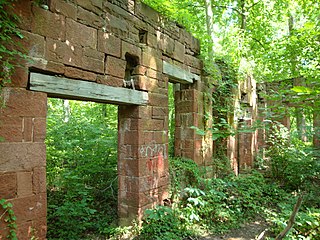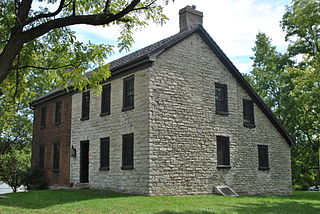
Xenia is a city in and the county seat of Greene County, Ohio, United States. Located in southwestern Ohio, it is 15 miles (24 km) east of Dayton and is part of the Dayton metropolitan area as well as the Miami Valley region. The name comes from the Greek word Xenia (ξενία), which means "hospitality".

Indiana limestone is a form of limestone used as a building material, particularly for monumental public structures. Some 35 of the 50 state capitol buildings in the United States are made of Indiana limestone, as are the Empire State Building, Biltmore Estate, and National Cathedral in Washington, D.C..

Hokie Stone is a grey dolomite—limestone rock found near Blacksburg, in western Virginia. It gets its name from the traditional nickname attributed to students and alumni of Virginia Tech.

Brownstone is a brown Triassic–Jurassic sandstone that was historically a popular building material. The term is also used in the United States and Canada to refer to a townhouse clad in this or any other aesthetically similar material.

Tennessee marble is a type of crystalline limestone found only in East Tennessee, in the southeastern United States. Long esteemed by architects and builders for its pinkish-gray color and the ease with which it is polished, this stone has been used in the construction of numerous notable buildings and monuments throughout the United States and Canada, including the National Gallery of Art and the National Air and Space Museum in Washington, D.C., the Minnesota State Capitol, as well as parts of the United States Capitol in Washington, Grand Central Terminal in New York, and Union Station in Toronto. Tennessee marble achieved such popularity in the late-19th century that Knoxville, the stone's primary finishing and distribution center, became known as "The Marble City."

Seneca Quarry is a historic site located at Seneca, Montgomery County, Maryland. It is located along the Chesapeake and Ohio Canal on the north bank of the Potomac River, just west of Seneca Creek. The quarry was the source of stone for two Potomac River canals: the Patowmack Canal on the Virginia side of Great Falls; and the C&O Canal, having supplied red sandstone for the latter for locks 9, 11, 15 - 27, and 30, the accompanying lock houses, and Aqueduct No. 1, better known as Seneca Aqueduct, constructed from 1828 to 1833.

The Isaac Pollack House is a historic structure now located at 208 West Monument Avenue in Dayton, Ohio, United States. Built in 1876, this Second Empire house was originally home to the family of Isaac Pollack, a prominent Dayton businessman involved in the liqueur trade. The walls are composed of a mixture of stone and brick with some wooden elements, resting on a stone foundation and covered with a slate roof.

Sacred Heart Catholic Church is a historic Catholic church building in downtown Dayton, Ohio, United States. Constructed at the end of the nineteenth century for a new parish, it closed in 1996, but was reopened in 2001 when a Vietnamese Catholic group began to use the church. This church building remains significant because of its grand architectural elements, which have led to its designation as a historic site.

First Presbyterian Church is a Presbyterian church in the city of Napoleon, Ohio, United States. Located at 303 W. Washington Street, it has been recognized as a historic site because of its unusual architecture.

The Bank of Xenia is a historic former bank building in downtown Xenia, Ohio, United States. Built in 1835, it was the location of Greene County's first bank, which opened on June 1 of that year. For thirty years, the building was used as a bank, becoming the local branch of the State Bank of Ohio in 1846 and changing its name to First National Bank in 1863. After First National moved to a newer building in 1865, it was no longer used as a bank; among its later owners was A.C. Messenger, a physician who used it as his home and office. In the 1880s, the bank was a party to a lawsuit known as Xenia Bank v. Stewart, which was decided by the United States Supreme Court in 1885.

St. Mary's Catholic Church is a historic Catholic church building in an eastern neighborhood of Dayton, Ohio, United States. Constructed at the beginning of the twentieth century, it remains home to an active parish. Its grand architecture has made it an aviator's landmark, and it has been named a historic site by the federal government.

The Lewis Kemp House is a historic pioneer farmstead in the city of Dayton, Ohio, United States. Built for one of the area's earliest residents, it was a religious center in its first years, while later years saw its expansion to its present form. Now located among much newer houses, it is Dayton's oldest surviving residence, and it has been named a historic site.

The Samuel N. Patterson House is a historic residence in the city of Xenia, Ohio, United States. Built in the 1860s, it was named a historic site in 1976.
Indian Mound Reserve is a public country park near the village of Cedarville, Ohio, United States. Named for two different earthworks within its bounds — the Williamson Mound and the Pollock Works — the park straddles Massies Creek as it flows through a small canyon.

The Yellow Springs Historic District is a large historic district that encompasses the majority of the village of Yellow Springs, Ohio, United States.

The Jamestown Opera House is a historic government building and community center in the village of Jamestown, Ohio, United States. It has been named a historic site because of its well-preserved architecture. Besides serving as a theater, the opera house has functioned as the community's village hall, its fire station, its post office, and its library.

The Wright-Patterson Air Force Base Mound, designated 33GR31, is a Native American mound near the city of Dayton in Greene County, Ohio, United States. Named for its location on an Air Force facility, Wright-Patterson Air Force Base, the mound is an archaeological site.

The Ballard Road Covered Bridge is a historic wooden covered bridge in the southwestern part of the U.S. state of Ohio. Built in the late nineteenth century and since bypassed, the bridge has been named a historic site.

The Woodbury Granite Company (WGC) was a producer of rough and finished granite products. Incorporated in 1887, purchased and significantly reorganized in 1896, and expanded by merger in 1902 and thereafter, the company operated quarries principally in Woodbury, Vermont, but its headquarters and stone-finishing facilities were located in nearby Hardwick. Beginning as a quarrier and seller of rough stone, the company expanded into the business of finishing cut stone and grew from there. It made its name as a supplier of architectural (structural) granite, and grew to become the United States' largest producer, supplying the stone for many notable buildings, including several state capitols, numerous post offices, and many office buildings.























